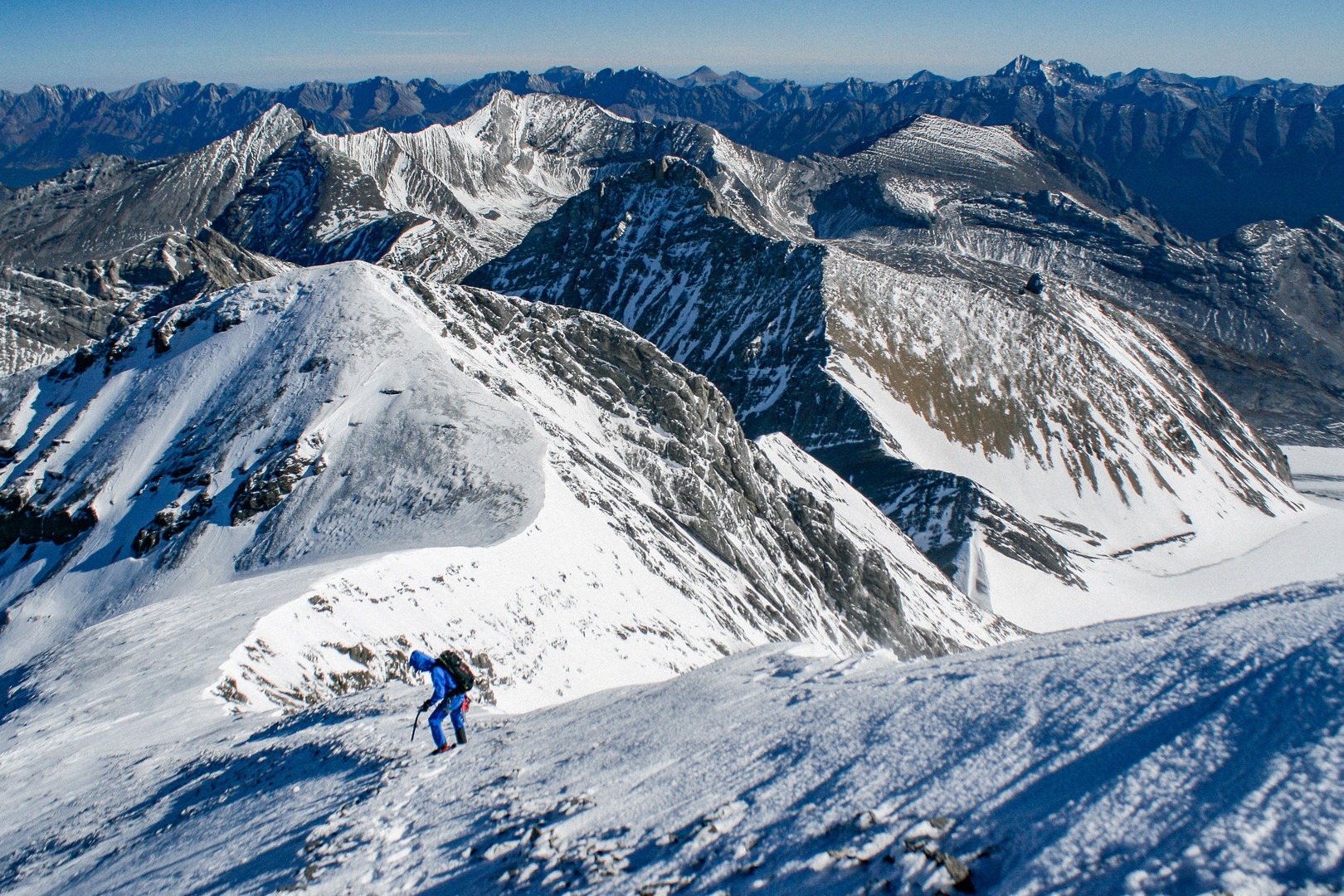You are here
Not to be confused with Joffre Peak near Pemberton, B.C., Mount Joffre is the second southernmost 11er and sits among a large series of incredible peaks. The north face of the route is covered by a large blanket glacier with the southern face a steep, forbidding mass of ice and rock. The route can be done in winter on skis or on foot in summer conditions.
Avalanches are the primary risk as the classic route directly up the convex rolling north face is the most obvious. With sun, it becomes prone to avalanches. The northwest ridge is a less-traveled route, but takes a gully up and traverses the face. While there is less avalanche risk, by mid-morning the route begins to experience rock fall from above, and it is advisable to be off the route quickly as some debris does get funneled into the gully. Plan accordingly.
The trailhead leaves from the southernmost carpark on Upper Kananaskis Lake. The lakeside trail weaves along the western shore before abruptly heading uphill through a newer trail. Follow signs for Aster Lake. The trail rises up before getting to a lovely, peaceful lake aptly named Hidden Lake. Keep following the trail as it climbs up a talus and scree face. The trail is okay through here and heads straight beneath a waterfall before going up 8 meters through a break in the rock with a few Class III moves that are tricky if you over-packed.
From here, the trail is increasingly spectacular. Rolling hills and larches with small dotted lakes make this spot incredibly charming. It has all the beauty of Lake O'Hara, but the long hike makes is barely known. The campsite sits just a bit above these meadows. In past years, folks would camp at the edge of the Joffre Glacier. While a much more attractive option, parks staff forebid it, and there are no permits allocated.
The campsite at Aster Lake will have to do. It offers a nearby river and several open spaces to place a tent as well as a bizarre, green conical toilet and food lockers. Once you've set up camp, it's well worth taking a stroll to check out the wide glacial valley beneath Mount Joffre. On top of being beautiful, it can be helpful to scope out the complicated approach through the talus. In daylight, it's easier to follow the Northridge Traverse Trail, which breaks off with numerous cairns guiding you through the talus. It can be tricky to follow these at night, so pick your route wisely.
In the early morning, you will work your way through the talus to the glacier's edge. Route finding is tricky in the dark, and without light talus can be very misleading. Attempt to follow the cairns that eventually gain a shelf for more efficient travel. Alternatively, you can stay in the valley and ascend a steep gully that begins near the ridge itself.
Once on the glacier, the route is quite straightforward. Weaving through crevasses, you make your way directly to the wide face of Mount Joffre. If you want to avoid this face, the gully on the northeast ridge becomes obvious once you've gained a bit of elevation. It's an easy walk across the glacier to it's base. The gully has several smaller gullies, the southernmost being the best option as it is the most sheltered.
Provided the temperatures are cool enough, it's a straightforward bootpack toward the top of the gully. At the top, it does get a bit icy and may require some low-angle ice climbing. From here, the route traverses across a face. Moving onto the rock, the route gets a bit more challenging depending on the snow. While only about 40 degrees, the scree on the rock face is very fine in years of low snowpack, and it makes for inconsistent and wobbly footholds. The 100-meter drop immediately beneath this leaves little room for error.
Once you have delicately moved past this section, the route becomes very straightforward. Follow the ridge to the summit. It's a broad wide ridge that gets less and less steep as you continue, creating the illusion that you are always only 5 minutes from the summit. It's a slog for sure.
The summit itself is a bit unique. A wide, flat, open space gives way on the southern flank to a near-vertical face. and above this abyss is a 1-foot-wide ridge extending into the air. If one crouches down, it's apparent that this little bump is about 30 centimeters higher than the nice, comfortable, and wide platform. To get the summit, you will have to walk this narrow and precarious ridge. When frozen, it is solid, if precarious.
Once the true summit has been achieved, it's time to retreat back down the same route. Due to loose rock, the gully isn't easily rappelled, so down-climbing is necessary. Be warned: With warmth, rockfall threatens. The route follows a secondary gully, which avoids the worst of the rockfall. But that decision should be made when you get there. Once back on the glacier, it's a a long walk out back to the cars. In winter, this is much faster and can easily be done in a day.
Logistics + Planning
Current Weather: Powered by Dark Sky





























Comments
Sign In and share them.